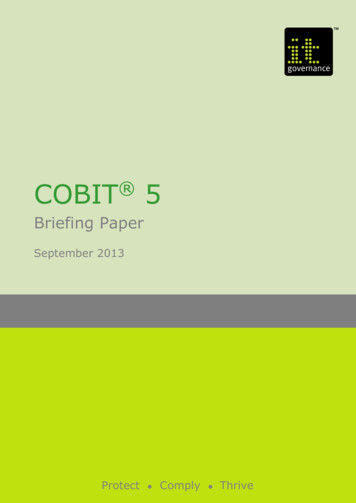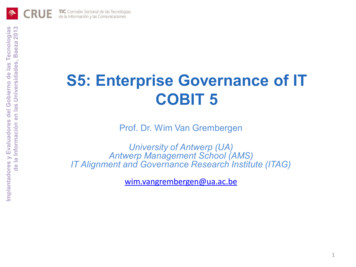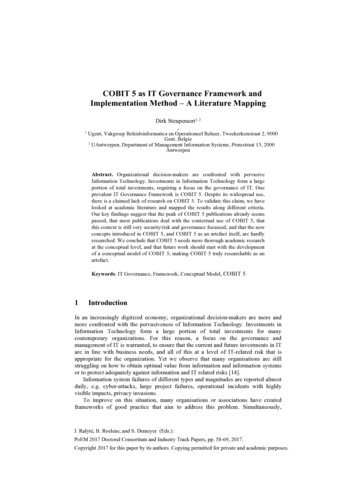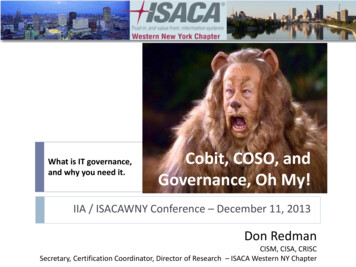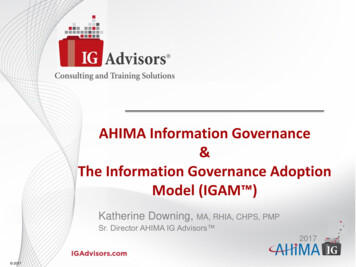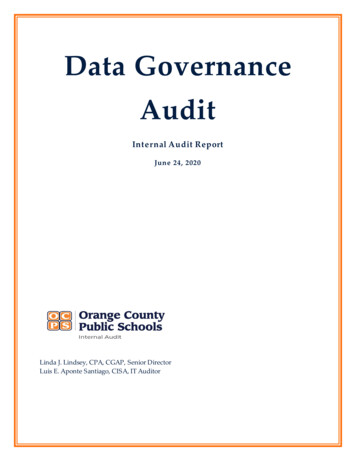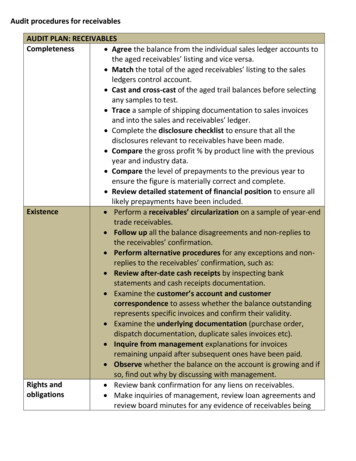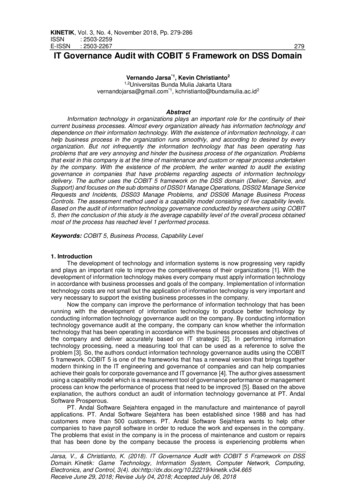
Transcription
KINETIK, Vol. 3, No. 4, November 2018, Pp. 279-286ISSN: 2503-2259E-ISSN: 2503-2267279IT Governance Audit with COBIT 5 Framework on DSS DomainVernando Jarsa*1, Kevin Christianto2Universitas Bunda Mulia Jakarta Utaravernandojarsa@gmail.com*1, on technology in organizations plays an important role for the continuity of theircurrent business processes. Almost every organization already has information technology anddependence on their information technology. With the existence of information technology, it canhelp business process in the organization runs smoothly, and according to desired by everyorganization. But not infrequently the information technology that has been operating hasproblems that are very annoying and hinder the business process of the organization. Problemsthat exist in this company is at the time of maintenance and custom or repair process undertakenby the company. With the existence of the problem, the writer wanted to audit the existinggovernance in companies that have problems regarding aspects of information technologydelivery. The author uses the COBIT 5 framework on the DSS domain (Deliver, Service, andSupport) and focuses on the sub domains of DSS01 Manage Operations, DSS02 Manage ServiceRequests and Incidents, DSS03 Manage Problems, and DSS06 Manage Business ProcessControls. The assessment method used is a capability model consisting of five capability levels.Based on the audit of information technology governance conducted by researchers using COBIT5, then the conclusion of this study is the average capability level of the overall process obtainedmost of the process has reached level 1 performed process.Keywords: COBIT 5, Business Process, Capability Level1. IntroductionThe development of technology and information systems is now progressing very rapidlyand plays an important role to improve the competitiveness of their organizations [1]. With thedevelopment of information technology makes every company must apply information technologyin accordance with business processes and goals of the company. Implementation of informationtechnology costs are not small but the application of information technology is very important andvery necessary to support the existing business processes in the company.Now the company can improve the performance of information technology that has beenrunning with the development of information technology to produce better technology byconducting information technology governance audit on the company. By conducting informationtechnology governance audit at the company, the company can know whether the informationtechnology that has been operating in accordance with the business processes and objectives ofthe company and deliver accurately based on IT strategic [2]. In performing informationtechnology processing, need a measuring tool that can be used as a reference to solve theproblem [3]. So, the authors conduct information technology governance audits using the COBIT5 framework. COBIT 5 is one of the frameworks that has a renewal version that brings togethermodern thinking in the IT engineering and governance of companies and can help companiesachieve their goals for corporate governance and IT governance [4]. The author gives assessmentusing a capability model which is a measurement tool of governance performance or managementprocess can know the performance of process that need to be improved [5]. Based on the aboveexplanation, the authors conduct an audit of information technology governance at PT. AndalSoftware Prosperous.PT. Andal Software Sejahtera engaged in the manufacture and maintenance of payrollapplications. PT. Andal Software Sejahtera has been established since 1988 and has hadcustomers more than 500 customers. PT. Andal Software Sejahtera wants to help othercompanies to have payroll software in order to reduce the work and expenses in the company.The problems that exist in the company is in the process of maintenance and custom or repairsthat has been done by the company because the process is experiencing problems whenJarsa, V., & Christianto, K. (2018). IT Governance Audit with COBIT 5 Framework on DSSDomain. Kinetik: Game Technology, Information System, Computer Network, Computing,Electronics, and Control, 3(4). eive June 29, 2018; Revise July 04, 2018; Accepted July 06, 2018
ISSN: 2503-2259; E-ISSN: 2503-2267280combining the work in a project. Therefore, the author's contribution to the company is to find outthe problems that exist in the company so that the authors can perform audits to obtain thecapability level that has been achieved by the company at this time and to know the next stepsthat can be done to improve the process by conducting an audit of technology governanceinformation using the COBIT 5 framework.In this study the authors took three previous studies relevant to the research theme takenby Johanes Fernandes Andry in 2016 in a journal entitled "Audit of IT Governance Based onCOBIT 5 Assessments: A Case Study", which revealed that the application of IT Governancehowever is a challenge for every organization to ensure IT is aligned with business goals. Thepurpose of this study is to illustrate the performance of information technology governance todetermine the extent of information technology governance skills in the Training Center arecurrently running, with several aspects to consider in an organization. The result of this study isthe average in the DSS domain has reached the value of 2.2 to 2.8 which means it is in themanaged process [6]. Tedi S. Agoan, Hans F.Wowor and Stanley Karouw in 2017 in a journalentitled "An analysis of the maturity level of information technology at the Manado communicationand informatics office using the COBIT 5 domain Evaluate, Direct, Monitor (EDM) and Deliver,Service , and Support (DSS) ", which revealed that the use of IT in agencies needs to be analyzedfor the level of maturity assessment or self-assessment in knowing the condition of IT andorganization and internal to know how far the benefits of the use of IT in agencies. The results ofthis study are the average reached maturity level 3 (established process) for the domain Evaluate,Direct, Monitor (EDM) and maturity level 2 (manage process) for the domain Deliver, Service,Support (DSS) [7]. The next previous research was conducted by Pistia Octaviyanti and JohanesFernandes Andry in 2018 in a journal entitled "Enterprise Asset Management Audit Using theCOBIT Framework 5", which reveals that the Enterprise Asset Management (EAM) system canassist companies in asset management and EAM implementation which can either extend the lifeof the assets to the company. The purpose of the EAM system audit is to optimize valuecontribution, manage change in a controlled manner, and manage assets so as to provide moreprofit for the company. The result of this research is capability level on process of EDM02 reachlevel 3, capability level on process of BAI06 is 2,75, and capability level in BAI09 process is 2,8.The result of gap analysis on EDM02 process is 1, at BAI06 equal to 0,25, and at BAI09 0,2 toreach expected level [8].2. Research MethodFigure 1. Research Method [8]Here is an explanation of the flow or stages of research conducted by researchers basedon Figure 1, namely:1. The researcher conducts literature study by finding the theories needed for this research.2. Researchers stated that the domains and processes used in this research are DSS01 ManageOperations, DSS02 Manage Service Requests and Incidents, DSS03 Manage Problems, andDSS06 Manage Business Process Controls.KINETIK Vol. 3, No. 4, November 2018: 279-286
281KINETIKISSN: 2503-2259; E-ISSN: 2503-22673. At the analytical stage the researcher system collects data relating to activities on the domainof DSS01 Manage Operations, DSS02 Manage Service Requests and Incidents, DSS03Manage Problems, and DSS06 Manage Business Process Controls. and make interviewquestions according to the domains and sub domains used.4. The researcher interviewed the party responsible for the company's information system basedon the domain of DSS01 Manage Operations, DSS02 Manage Service Requests andIncidents, DSS03 Manage Problems, and DSS06 Manage Business Process Controls.5. Researchers do the analyze on the results of interviews that have been done based on theassessment scale on COBIT 5, there are 5 levels on the capability level, which are as follows:a. Level 0: Incomplete process; the process is not implemented or failed to achieve thepurpose of the process. There is little or no evidence of achieving the objectives of theprocess systematically.b. Level 1: Performed process; the implementation of the process has reached its goal.Attributes at this level are:PA 1.1 Process performance; measures the extent to which the objectives of a processhave been achieved.c. Level 2: Managed process; process 1 at level 1 is implemented into a process regulation(planned, monitored, and evaluated) and the work product of the process is properlydefined, controlled and maintained. Attributes at this level are:PA 2.1 Performance management: measures the extent to which the implementation of theprocess is governed.PA 2.2 Work product management: measures the extent to which the work product isproduced by a well-regulated process.d. Level 3: Established process; the process at level 2 is implemented using a defined processand able to achieve process results. Attributes at this level are:PA 3.1 Process definition: measures the extent to which a process is defined to support theexecution of a process.PA 3.2 Process deployment: measures the extent to which process standards areimplemented effectively.e. Level 4: Predictable process; process at level 3 runs with a defined boundary to achieveprocess results. Attributes at this level are:PA 4.1 Process measurement: measures the extent to which measurement results are usedto ensure the implementation of processes can support the achievement of organizationalgoals.PA 4.2 Process control: measures the extent to which the process is managed quantitativelyto produce a stable and predictable process in accordance with defined boundaries.f. Level 5: Optimizing process; the process at level 4 is continually upgraded to meet currentand future organizational goals. Attributes at this level are:PA 5.1 Process innovation: measures the extent to which process changes are identifiedfrom the implementation of the process and from the innovation approach to theimplementation of the process.PA 5.2 Process optimization: measures the extent to which changes are defined, managesthe implementation of processes effectively to support the achievement of processimprovement objectives.6. The author calculates the interview result according to the capability model to determine thecapability level of the company by calculating the average capability level of each subdomain,that is by formula: total number of subdomain / subdomain value. Example: ((DSS01-01 DSS01-02 DSS01-03 DSS01-04 DSS01-05) / 5 average of capability level from DSS01domain).7. Researchers conduct analysis and provide recommendations on information systems thatneed to be improved in order to improve the information system in accordance with what isexpected by the company.8. The last stage in this research is to make a report of the results of research that has beendone.3. Results and DiscussionAt this stage the researcher will discuss about the result of information technologygovernance audit using COBIT 5 framework with capability model assessment that can measureIT Governance Audit with COBIT 5 Framework on DSS Domain Vernando Jarsa, Kevin Christianto
ISSN: 2503-2259; E-ISSN: 2503-2267282the performance of the process at the company so it can know the value of each process. Theresults and discussion of this information technology governance audit are values of capabilityand recommendation of each process in the domain. The domains used in the research areDeliver, Service and Support (DSS) consisting of DSS01 Manage Operations, DSS02 ManageService Requests and Incidents, DSS03 Manage Problems, and DSS06 Manage BusinessProcess Controls.3.1 DSS01 Manage OperationsThis process discusses coordinating and executing the operational activities andprocedures required for internal IT and IT outsourcing services, including the application ofpredefined SOPs and required monitoring activities. The purpose of this process is to produce IToperational services in accordance with the wishes of the organization.In the DSS01 domain, the company has not maintained, performed and implementedoperational procedures consistently because there are no specific SOPs for IT. There are onlySOPs in general and for IT infrastructure, especially in monitoring event logs and periodic reviewof the event logs; outsourced IT services to safeguard corporate information protection andservice delivery, then the company has not yet undertaken any training to anticipate in case ofnatural or human-error, health and safety training, as well as no facilities to assist in the event ofa power outage. Then the capability level in DSS01 domain is 1.6 which means only achieveperformed process.Recommendations for DSS01 domains are proposed by companies to backup data everyweek to be more effective and efficient, then implement more specific SOPs for IT not only ingeneral and in monitoring event logs and routinely review existing event logs to monitor eventlogs running in accordance with the desired company related to the IT infrastructure, using IToutsourced and ensuring that company requirements for enterprise information security arecomplied with in accordance with the contract, ensuring that IT priority for service delivery isadhered and integrating internal IT management with outsourced service providers, the next istraining how to use tools to anticipate in the event of a natural disaster
COBIT 5 Assessments: A Case Study", which revealed that the application of IT Governance however is a challenge for every organization to ensure IT is aligned with business goals. The purpose of this study is to illustrate the performance of information technology governance to determine the extent of information technology governance skills in the Training Center are currently running, with .
